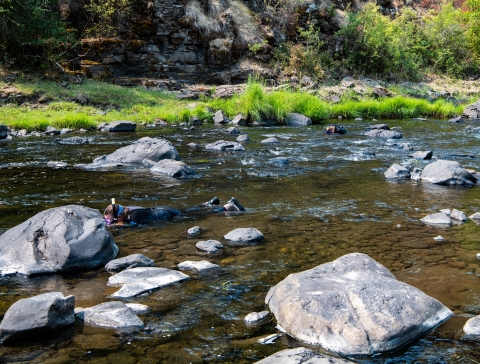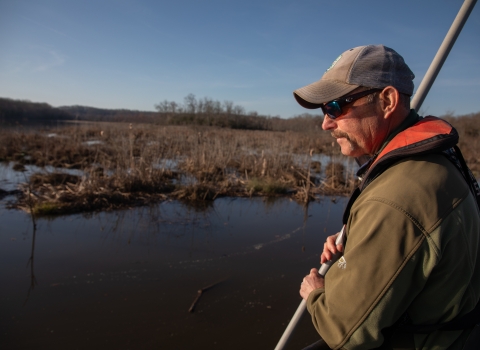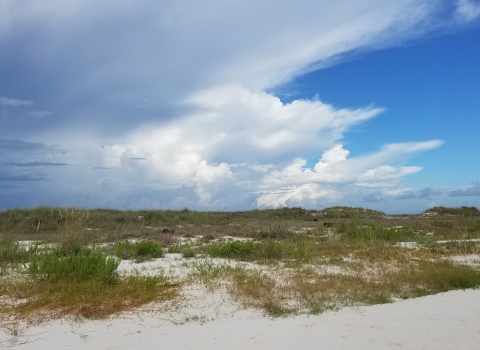U.S. Fish & Wildlife Service to Examine the Status of the Western Ridged Mussel Later This Year
The status of a species that is largely invisible most of the time but key to both native culture and the health of rivers in the Pacific Northwest will be getting a closer look. According to some biologists, freshwater mussels are experiencing population declines. One of the species raising concern, the western ridged mussel (Gonidea angulata), will be the subject of a Species Status Assessment by the U.S. Fish & Wildlife Service in 2022, a prerequisite for any future decision that may list the species under the Endangered Species Act.
Alexa Maine, an expert at the forefront of mussel research, knows the western ridged mussel well. She has closely studied the mussel and its close relatives for nearly a decade as a Lead Biologist with the Confederated Tribes of the Umatilla Indian Reservation (CTUIR). As part of her research, she makes repeated and regular visits to underwater mussel beds in places like the North Fork of the John Day River. One of her routine field visits during the heatwave of June 2021, however, left her shaken. She had visited the familiar site many times. On that day, the river felt more like a hospital ward.
“It was one of the most devastating field days in my career,” she says. The same mussels she had seen again-and-again were stressed. Many of them were open, agape, and slow to close. The animals are usually buried in the sediment or gravel at the bottom of the river. When they have “popped themselves out,” of the sediment as they had that day, Maine says, it is akin to a death knell. The typically sedentary creatures were making a last-ditch effort to find a better location. Additionally, an open mussel will normally close in self-defense when it detects a shadow. The slow or strained response that Alexa Maine witnessed during that survey is indicative of poor health.
That jarring experience, however, may be part of a larger trend. Of the sites that Maine monitors regularly in Northeastern Oregon, only two have stable or increasing populations. Eight of her ten sites have declined, with some of them dying-off completely. One of the locations, she notes, used to have 500 mussels per square meter. It is now down to zero.
Mussel populations can decline for a variety of reasons including pollution, high temperatures, or invasive species invasive species
An invasive species is any plant or animal that has spread or been introduced into a new area where they are, or could, cause harm to the environment, economy, or human, animal, or plant health. Their unwelcome presence can destroy ecosystems and cost millions of dollars.
Learn more about invasive species . According to Maine, the reason for the declines that she has witnessed are unknown, but it’s a race against time. “There are populations we wanted to study but die before we can begin,” she says.
"Livers of the Rivers"
To most people, a freshwater mussel may not appear to be the portrait of charisma. They have been described dismissively by some as “rocks with guts.” But their nondescript appearance, excellently camouflaged in their out-of-the-way habitat at the bottom of rivers, can be deceiving. “They do a lot of work behind the scenes,” says Courtney Newlon, Biologist with the U.S. Fish & Wildlife Service. Newlon notes that much like a liver, mussels remove sediment, pollution, and bacteria from the water column. A bed of 1,000 freshwater mussels can remove up to two kilograms of particulate matter (nearly 4.5 pounds) from the water per year. Extrapolated across an entire ecosystem, those services can have a big effect.
Mussels are also indicator species. They may be some of the first animals in an ecosystem to react to hazards like pollution or temperature changes that may soon affect more renowned species like salmon. Among mussels, the western ridged mussel is particularly sensitive, according to Alexa Maine. Beyond being a canary in the coalmine, western ridged mussels may be a “canary of the canaries.”
A Pillar of Native Culture
Since time immemorial, mussels have also been an important cultural resource for the Tribes along the Columbia River and its tributaries. Freshwater mussels are considered a “First Food” for Tribes like the Umatilla, meaning that it was a staple of the diet that was consumed for countless generations before European contact.
Historically, mussels would be harvested from rivers in the region in large quantities, then prepared by boiling or steam-baking them in ground ovens. For longer-term storage, mussels can also be dried in the sun or hung on strings to dry. Mussel shells were also an important form of currency for native peoples, traded for a variety of uses including adornment on clothing and as tools. That important cultural rhythm, however, has been disrupted. In many of the areas where mussels were once harvested, doing so is no longer practicable. Mussel numbers have declined in many waterways and in others become unsafe to eat. The shells that were once so versatile as tools and decoration are now thinner than they were historically, limiting their uses.
Recovery and Research Efforts
Today, mussels are no longer gathered by native peoples in the way they once were, but it is hoped that one day the mussel’s place at the dinner table can be restored. Alexa Maine and Donna Nez of the Confederated Tribes of the Umatilla Indian Reservation are leading efforts to propagate and grow young mussels in a lab in order to outplant them and reestablish populations. CTUIR’s program is currently the only freshwater mussel propagation operation in the West.
A great deal also remains unknown about mussel species. “There is more than a century of studies behind salmon,” Alexa Maine of CTUIR notes. “But when it comes to mussels, we don’t know the genera, the life history… there are a lot of blanks still.” While these gaps in knowledge persist, biologists look at declining populations and reports of die-offs with concern.
Accordingly, as one of the agencies charged with administering the Endangered Species Act, the U.S. Fish & Wildlife Service in 2022 will begin to compile data about the western ridged mussel in a formal Species Status Assessment. The Service previously found in an initial 90-day finding that listing of the species under the Endangered Species Act may be warranted. This more comprehensive forthcoming report will examine in further depth the species’ life history, current condition, and provide a prognosis for its likely future condition. It will gather data from different sources, partners, and the five states in which it is found, developing a clearer picture of the mussel’s overall status across its large range. Though a lot of questions remain, it is hoped that the assessment will help contribute to a brighter future for this important river resident.






